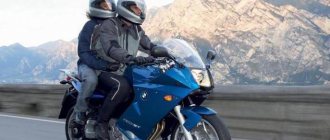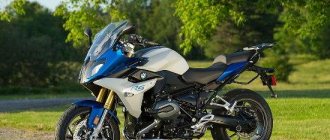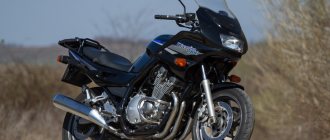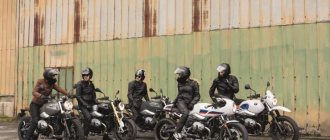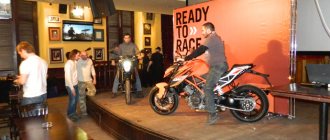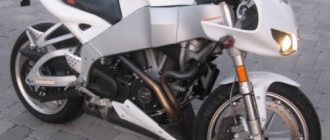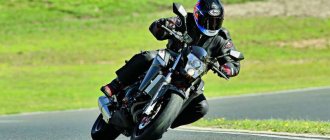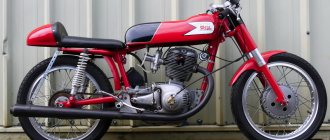BMW F800GT – TEST
Admission ticket
2013 onwards, 798 cm³, 90 l. pp., 213 kg (curb weight), from RUB 549,000.
text: Alexander Barkalov photo: Vladimir Levechev
in the photo: Alexander Barkalov
“For decades, the iconic models of the Bavarian concern BMW Motorrad have been the living embodiment of the class of touring machines for a huge number of motorcyclists . And it doesn’t matter so much whether we were talking about the GS family of all-terrain “rogues” or luxury tourers RT and GT - devices with a two-color propeller on the tank have always met the highest expectations of travel enthusiasts. However, a very impressive price even for models with basic equipment significantly reduced the flow of customers wishing to join the crowd of owners of premium brand motorcycles. Who knows, maybe the F800GT will be the key that will open the door to the world of BMW touring motorcycles, previously inaccessible to most consumers!
Relatives The presentation of the new BMW touring model took place at the EICMA international motorcycle show last year, but even the most notorious marketer, who has long lost the remnants of his conscience, would not dare to call the F800GT a motorcycle created from a “clean slate”. By and large, the Bavarian new product is the successor to the budget model F800ST, which was born in 2006. The lion's share of well-proven components and assemblies migrated from ST to GT, including the two-cylinder in-line engine. The proven and more than once proven reliability of the 798 cc liquid-cooled twin, also installed by the company on many other models, had undergone only minor changes by the time it was “implanted” into the F800GT chassis. In technical terms, the engine remained the same, but different injection maps allowed German engineers to slightly increase the peak power and torque figures. Compared to the F800ST, the engine power of the GT modification increased by 5 “horses” and reached the 90-horsepower mark, demonstrated at 8000 rpm. The two-cylinder engine produces a peak torque of 86 Nm at 5800 rpm, which allows for fairly dynamic acceleration in the widest speed range.
Naturally, you shouldn’t expect the excitement of an inline-four from a parallel twin: acceleration stops, and the engine begins to noticeably run out of steam as the tachometer needle approaches the red zone. Unfortunately, even the modified engine could not get rid of its signature feature in the form of vibrations that arise at high speeds. However, tremor is not a serious drawback, because it is unlikely that anyone in their right mind would think of pushing the tachometer needle “to the cutoff” after covering an 800-kilometer stretch. It is pleasant to note that a small increase in power and torque, although they could not radically change the character of the power unit, definitely made its operation more delicate, eliminating strain when driving at high speed.
Gran Turismo The GT prefix that appears in the name of the model categorically states that from a city motorcycle, the F800 has retrained, albeit a small one, but a conqueror of space, capable of covering thousands of kilometers in search of vivid impressions. To meet the new challenges, BMW engineers had to significantly modify both the plastic lining of the motorcycle and its ergonomics, as well as work some magic on the chassis. But first things first. As befits a “tourist,” the front fairing of the BMW F800GT has become much more massive: the plastic “nose” has expanded not only in width, but also noticeably stretched upward, giving the car a finished look. The windshield, although not adjustable, has also grown in all directions. Experience has shown that the dimensions and shape of the front fairing of the F800GT should be considered almost ideal for a driver of average height. In almost all speed modes, the plastic linings coped with the task perfectly, reliably diverting the flow of incoming air.
BMW also worked on the ergonomics of the driver's seat. And, despite the fact that the changes made at first glance are not so dramatic, sitting behind the wheel of the GT is noticeably more comfortable than the F800ST. Thanks to the fact that the steering wheel was raised by 20 mm and moved closer to the driver, and the shape of the gas tank was completely changed, there was noticeably more space for the pilot. Moreover, even drivers whose height is above average will not experience a particular shortage of free space. To make the rider's legs less tired, the footpegs were moved one and a half centimeters forward and down, and the seat was made wider and installed lower than on the ST version. Other changes affected the motorcycle's suspension. First of all, the fork travel was reduced by one and a half centimeters, which was done to increase control accuracy. On the other hand, the “nimbleness” of the device was sacrificed for stability at high speeds: the rear suspension pendulum was lengthened by 50 mm, which increased the wheelbase to an impressive 1514 mm. However, these are only theoretical calculations based on dry numbers - in fact, the motorcycle’s handling remained approximately at the level of the F800ST model. Even a fairly decent 213 kg of curb weight does not prevent the device from easily and comfortably passing the sharpest turns at decent speeds. It is worth saying that the Electronic Suspension Assist electronics package is installed as an option on the F800GT, which allows you to adjust the rear suspension on the go in three main positions: Comfort, Normal and Sport. To be honest, during everyday use, switching between modes, I didn’t feel much difference in the behavior of the motorcycle. Significant differences between the “comfortable” and “sporty” monoshock settings were revealed only on the go-kart track.
The road The developers conceived the BMW F800GT as a touring motorcycle, so the only sure way to unlock its full potential was to travel and, if possible, travel further. It was decided to test the new BMW on the road to the capital of Lithuania, Vilnius. Almost 1000 km of travel to the largest city of the Republic of Lithuania gave a clear understanding of the capabilities of the new product of the Bavarian concern. For testing, I got an F800GT, equipped with a set of branded cases - two side cases with a total volume of 55 liters and a central one with a capacity of 28 liters. Although hard side bags do not amaze with their dimensionless internal space, they can accommodate quite a lot of luggage.
True, comfortable urban operation of a motorcycle with such an additional weight seems to be an unfeasible task. The fact is that the dimensions of the side cases significantly exceed the width of the motorcycle handlebar, which often forces you to find yourself in an unpleasant situation when, moving between the rows, you risk hitting neighboring cars. In addition, the presence of panniers is noticeably felt when driving at high speeds and especially when “warming up” with oncoming traffic. In such cases, the additional luggage equipment begins to actively resist the oncoming air flow, unloading the front wheel and at the same time playfully wagging the rear of the motorcycle... However, after several tens of kilometers of travel you get used to this feature, and the slight “bumpiness” is no longer very distracting.
You gain even more confidence in the motorcycle on wet roads. As an option, the GT is equipped with ASC traction control, the need for which many may consider unnecessary due to the relatively modest engine power. I am inclined to say that the extra money paid for the electronic “lotion” will pay off more than once on a long journey, where wet asphalt, bitumen stains and sand in corners are far from rare phenomena. Speaking of electronic assistants, do not forget about ABS, which is included in the basic package of the F800GT. In general, the braking system, consisting of two 320 mm discs and 4-piston Brembo calipers on the front wheel and a 265 mm disc and 1-piston caliper on the rear, copes well with the tasks, with excellent feedback and information content. The only factor that bothered me even before the start of the journey was the small fuel tank. Agree, 15 liters is not the amount of fuel reserve that you would expect to see on a touring motorcycle. However, doubts about the capabilities of the motorcycle were dispelled at the very first gas station, as soon as I took out the gas nozzle and looked at the gas station display. It turns out that, having traveled almost 200 km, the motorcycle barely used up half of its fuel reserve! A more accurate calculation of fuel consumption showed that at an average speed of about 120 km/h, the F800GT engine consumes approximately 4.2 liters of fuel. It turns out that the device is capable of covering 360 km on one tank, which saves a lot of time by reducing the number of refueling stops. If the speed is increased to 140–160 km/h, fuel consumption will increase by about a liter, which is also very acceptable.
Summing up the results of the test, I would like to say that in general the BMW F800GT is perceived as a really good touring motorcycle, perfect for both short weekend outings and serious European long-distance trips. In addition, the F800GT is a comfortable and very practical device for every day, perfect for use in a metropolis. For many, the Bavarian novelty can be just a step on the way to a large BMW touring motorcycle, or it can live in the garage for a long time, flawlessly performing daily transport tasks and sharing the joy of traveling together. Perhaps the main disadvantage of the model is its high cost. In the version with a very useful, but expensive complete “minced meat”, the price of the motorcycle exceeds 600,000 rubles! But is this so much for an entrance ticket to the world of real premium “tourists”?
BMW F800ST vs Honda VFR 800
My formal criteria for an ideal motorcycle are simple, they are a consequence of the intended mode of operation. Daily trips to work, a couple of large and several small long-distance trips per season, possible trips to Leader depending on the mood, and so that everything is beautiful and reliable - does this happen?
It happens, but not without compromises. For example, it seems to me that my GE in the Leader is not very good, although the British say the opposite. But you can go long distance in any direction. And the FJR1300 is good for everyone, but it’s not very convenient for work; it’s still wide and heavy. If you start looking closely at a model, it will definitely require a compromise in some way.
And recently it dawned on me - there are such motorcycles! I even rode a little on each one. They fell out of my sight for a simple reason - with my 190 cm, they are simply too small for me in size. But each one seems to satisfy all the formal requirements. To find out if this was true, I surfed foreign websites and gathered information. And in order to avoid writing two articles, I decided to present the material in the form of a comparison. So, what do foreign journalists write about these motorcycles?
Honda VFR 800
The motorcycle is a legend, it has been in production for 10 years, and if we take into account its direct ancestor VFR750, then more than twenty. Moreover, the first pick itself, which debuted in 1986, is a descendant of the series
, produced since 1982. This series apparently still gives Honda engineers and marketers nightmares, as it has become famous for its extremely unreliable engine.
The problem was the camshaft drive chain. Engineers struggled to solve the problem, in 1984 they redid the entire timing belt 8 (eight) times, but all in vain. As a result, the VFR series received a camshaft drive using gears, and this design, which lasted until 2002, became one of those technical highlights of the series for which fans appreciate it (by the way, we also have them).
Another feature, which will last over time, is the V4 engine itself, the advantages of which are its small width and the inherent absence of vibrations in such a design, so valued by truck drivers. However, the model was not deprived of various interesting technical solutions throughout its life. Radiators on the sides (like on the VTR Firestorm), a cantilever pendulum attached to the crankcase, combined brakes, optional ABS and even a VTEC system designed to combat the gas-dynamic limitations of internal combustion engines - everything was before us, everything flashed here.
In 2002, the sixth generation of the model was released, which was modernized in 2006. In particular, the VTEC system was reconfigured. Now the two valves are connected at 6600 rpm and disconnected at 6100. Previously, when the system was activated in both cases at 6800, the transition was too noticeable and uncomfortable, especially if it happened in a corner.
The main thing has not changed: the motorcycle is well-assembled, reliable and beautiful.
BMW F 800 ST
However, the first two epithets can equally be applied to our German hero. As for beauty, then, as they say, it’s not for everyone, but the device still looks quite unusual.
In historical terms, this bimmer also cannot boast of anything - devices with parallel twins have been sold only since 2007. Although depending on how you look at it. The Germans always had in their production program a junior small-capacity line in both the R and K series. Such devices were cheaper, and the taxes on them were lower, and in terms of performance they were not much inferior to their big brothers. But they stopped making small in-line engines in the mid-90s, and small boxers in the early 2000s, so this niche of the lineup remained empty for some time (650 cc engines don’t count). The new 800-current line can be considered, if not a constructive, then an ideological successor to small series.
Structurally, the bike, like all bimmers, is not very similar to its competitors. The in-line two-wheeler is not the most popular scheme in modern motorcycle construction, but all because it is not the most balanced from the start. BMW engineers (yes, a Rotax engine, but it was developed by the Bavarians) as always surprised everyone - to combat vibrations they came up with an engine that moves in a perpendicular plane. The tank was placed under the saddle, lowering the center of gravity, and the main drive was made by a belt, so that a Bimmer driver who switched to this motorcycle from another BMW would not have to master the procedure for lubricating the chain. Well, and the famous separate turn signal switches, where would we be without them? (The new K1300 series comes with regular switches - should we be happy or sad?)
The rest of the bike is also excellent. Excellent touring ergonomics, decent economy, good wind protection, legendary reliability, a convenient optional luggage system and a super-humane (over there) price - all this ensured a rapid start to sales of the model and the titles of the best sports tourer of 2007 from some magazines.
Let's see how, according to Western motorcycle journalists, these motorcycles look in comparison with each other.
Appearance. A lean, but some kind of chopped beamer and quite plump (especially with panniers), but quite a classic-looking van, subtly reminiscent of its older sister ST1300. It’s up to you to decide which is better; personally, I like the choice better.
Tidy. The Honda is equipped with a large, easy-to-read tachometer located in the center of the instrument panel, and two displays along the edges. The left one shows the speed and temperature of the coolant, the right one shows the odometers, the amount of fuel in the tank and the time. The Beemer's speedometer and tachometer look poorer, but if the motorcycle is equipped with a trip computer (and this is the only one sold on our market), then the screen, in addition to what Honda displays, shows the number of the gear engaged, fuel consumption, average speed and temperature. There's even a stopwatch! Thus, competitors present the potential buyer with a choice: functionality or beauty.
City. In the congested traffic jams of any metropolis, the Bavarian wins an unconditional victory. The Beemer is lighter than the Honda. Its center of gravity is lower. It can be ordered with a lowered saddle. It is wider than the Japanese one, but the wide steering wheel allows you to quickly change direction. The German engine has more torque, so it is easier to drive in conditions of constant changes in acceleration and deceleration and driving under pressure. In general, an excellent city motorcycle that is perfect for girls. A vyfer, of course, won’t help in the city either, but it will require more experience from the pilot. The only urban discipline in which the Japanese is a leader is braking; it is smooth, effective and predictable, while German brakes are harsh. Testers believe that this is the result of Honda's well-tuned combined system.
Route. The Bavarian offers a more upright riding position and a saddle shaped to the shape of the nurse. One of its advantages is also the fairly dense padding. The driver has a worse situation with this, as a result, on a long road the fifth point gets tired faster. In addition, the wind protection of the windshield only begins to work if the pilot bends down lower. But on the serpentines, the only miscalculation of the German ergonomists is revealed - the too sharp edges of the seat, which cut into the body when turning. On the other hand, the Japanese's sporty riding position and sharper steering geometry pair well with twisty roads. And the powertrain engine is not only almost 30% more powerful, it also demonstrates the famous VTEC pickup. As a result, all testers made the obvious conclusion - on boring autobahns, a Beemer is better, but for those who prefer active driving, you need to take the Japanese.
Price. In the damned bourgeoisie, motorcycles in basic configurations cost almost the same, the Beemer is even cheaper - $10,520 versus $10,799. More complete configurations also cost almost the same, moreover, the Germans offer a more extensive list of options. Oddly enough, such a pricing policy does not guarantee success; the decline in sales in America for BMW was almost 13%, while for Honda it was only 0.3%. Knowledgeable people say that the point here is that Honda has a reputation for being simpler and more reliable, and Bimmer dealers are considered small and arrogant. Our situation is somewhat different. Naked Bavarians are not for sale, they all come almost completely stuffed, which includes an on-board computer, a proprietary alarm system, ABS, heated grips and seats, and a tire pressure monitoring system. You just have to buy the panniers separately. Honda can only boast of ABS. As a result, the more powerful Japanese is sold 15% cheaper than the better-equipped German: 462,000 versus 529,000 thousand rubles. And then the biker, who has half a million in his pocket for a new device, again faces a difficult choice.
In one of the reviews, the journalist very accurately expressed the result of the comparison in one phrase: “here are six, and there are half a dozen.” It's up to you to decide which is better.
| BMW F800ST | Honda VFR800 | |
| Engine | Row two | V4 |
| Power | 84 hp | 107 hp |
| Torque | 86 Nm | 80 Nm |
| Power ratio | 0.4605 hp/kg | 0.4908 hp/kg |
| Transmission | 6 | 6 |
| main gear | Belt | Chain |
| Dry weight | 182 kg | 213 |
| Saddle height | 820 (790) mm | 805 mm |
| Length | 2082 mm | 2120 mm |
| Width | 860 mm | 735 mm |
| Base | 1466 mm | 1460 |
| Front tire | 120/70-17 | 120/70-ZR17 |
| Rear tire | 180/55-17 | 180/55-ZR17 |
| Front brake | Two 320 mm discs | Two 296 mm discs |
| Rear brake | One 265 mm disc | One 256 mm disc |
| Tank | 16 l | 22 |
For the 2015 season, I decided to change the XJ6, which I bought as the first motorcycle. If necessary, I will compare the XJ6 and F800GT. The main requirements for a motorcycle are suitability for driving around the city, one-day trips and long-distance trips. The peculiarities of choosing and purchasing motorcycles before the 2015 season are a different story)) As a result, a gray 2013 F800GT with a high saddle, which is called comfortable, visually differs from the basic one in the stitching and in that its material is more like leather, settled in my garage.
The motorcycle is in the maximum configuration: • ABS • Traction control system – can be disabled. • Heated grips • Adjustable suspension stiffness, rear only, front not adjustable • Tire pressure sensors • Standard alarm • Trip computer • Steering damper • Clock) The previous owner took good care of the motorcycle: additional goodies were installed: a hugger and additional drive belt protection, mudguard on the front fender, GIVI touring windshield, engine and axle sliders, Schnitzer steering wheel, footrest platform extender. As a bonus, I received an original and very voluminous tank bag - after installing the central trunk, it is lying in the garage.
Appearance Very good - harmonious in general and in detail: developed fairing, sharp hump of the false tank, gas tank neck near the seat, cantilever pendulum.
A separate holiday - LED tail light, license plate illumination and brake light - when the ignition is turned on in the dark, spectators express an admiring WOW!!! Key and alarm key fob: the key contains a chip on which the security system is linked; it is convenient that the motorcycle can be disarmed by turning the key. Apparently BMW engineers are prohibited from handling the keys of modern cars, so the key and the alarm remote control are downright miserable: the BMW badge on the key is a bulge, and the alarm remote control is painted with white paint, I haven’t seen such poverty for a long time...
Behind the wheel wheel is unusually wide (after the XJ6). Surprisingly thin steering grips - to the delight of court tuning manufacturers, Yamaha's grips are thicker and more comfortable.
After the Yamaha, the clutch is heavy - in traffic jams I work with four fingers, on the Yamaha it works fine with two and the hand does not get tired. It’s a small thing, but moving the entire hand to the clutch trigger is an additional operation when entering a traffic jam, which must be done with the clutch lowered, simultaneously with braking, shifting down and choosing the optimal row spacing.
Right remote control: the starter is made on one key with the ignition off - the ideal solution. On the top of the remote control there is a two-stage heating of the handles, there is an operation indication on the dashboard - it is well made and convenient, it heats up perfectly.
Left remote control: Turn signal switch with automatic shutdown - the algorithm of its operation is not optimal, sometimes it does not turn off, sometimes it turns off earlier than necessary, for example, if on a multi-lane road you need to change lanes from the far left to the far right - in short, it is a dangerous intellectual that needs to be constantly monitored. Buttons for adjusting the stiffness of the rear shock absorber and disabling the traction control system. At the top there is an emergency light and an on-board computer control button - instantaneous fuel consumption, air temperature, average speed and average fuel consumption, why there is no distance on the remaining fuel - a mystery, this simple function is available on many cars, but it didn’t work here... All other buttons are located in the usual places, comfortable and work perfectly, it’s convenient to shoot at long range, the signal is loud and impressive.
The instrument panel is archaic and clearly asymmetrical - dial speedometer, tachometer and large LCD display - fuel level, engine temperature, gear indicator, trip computer, warning lamps, the backlight turns on only in low light, glows in the signature orange color. Everything is easy to read except the speed – I’m more used to a large digital display.
The fuel level indicator does not usually work; due to the complex shape of the gas tank, the level is measured only when half is left - this is according to the instructions, in fact, when about a third remains, when there is a reserve left - the light comes on and the odometer turns on after switching to reserve, so I drove up to 50 km – didn’t dry out. You can only know how much gasoline is in the tank when it is low.
Another little nicety is the tire pressure indicator. For some unknown reason, this function is displayed on the same display as the mileage and is switched by a button on the dashboard. It’s inconvenient to use this button while driving, so you need to decide before you start driving whether you’re looking at mileage or pressure. The indicator is very smart - it shows the calculated pressure taking into account the temperature of the tires and the ambient air, you need to inflate the wheels by the difference between the readings of the indicator and the compressor pressure gauge, so it is almost impossible to pump up the required pressure the first time at a regular gas station, because you do not know what the deviation and there is an error in the pressure gauge at the gas station, and so that you do not try to deceive the system, the pressure indicator works while driving!!! Bravo, you inflated the tire and drove off to find out how much it was inflated, accelerated, found out and back to the compressor!!! After three attempts to pump up the required pressure, I decided that a deviation of 0.1 or 0.2 was normal, especially since the pressure gauge showed 3 when the required 2.9, but the indicator stubbornly showed 2.8. A useful feature that works great in combination with a branded dealership, or your own non-Chinese compressor with a calibrated pressure gauge!
Good wind protection, the legs are closed, in the rain little water gets on the boots, much better than on the Yamaha - the downside is that at temperatures above 30, even at a speed of 150-160 it is very hot, the air from the engine bakes the legs, this is an unforgettable feeling: you accelerate after traffic jams, now it will become cooler - and nothing... only the hot air begins to flow more intensely. The biggest advantage is a comfortable fit, the ability to choose and try on seats for different heights at the dealer, a choice of spacers for footpegs, an excellent motorcycle for long trips. The standard light illuminates the road well, there is no desire to improve or change anything, it is possible to switch the light for right-hand and left-hand traffic. The mirrors are adjustable without steps, fold up when dropped, and the visibility in them is no different from most motorcycles. There are vibrations, but they are not annoying, I have never experienced any discomfort. I like the sound of the engine, it’s not loud at idle, the angry growl when accelerating from low revs is very pleasing. The motorcycle has a 12V socket, the connector is a mini cigarette lighter, the location for the socket was chosen in a very original way - below the saddle under the right leg, in my opinion, it makes sense to connect only the original battery charger to this socket, I don’t understand why they didn’t put the socket at the steering wheel, and I will never be able to understand. When I travel, I put a power bank in my bag on top of the tank to charge my phone and use it. Out of habit, I tried to position the side stand by moving the toe of my foot - I failed - you need to remove it with your heel from the narrow gap between the footrest and the lever of the central stand, blindly there is little chance of getting where you want, you need to control the process visually, on a Yamaha everything is simpler - there is a spur for which The side stand can be easily picked up with the toe of your boot.
Engine The first trips caused, instead of “Delight,” a persistent feeling of bewilderment - I did not notice a noticeable increase in dynamics compared to the 600 cc Yamaha, on the contrary, there is a clear lack of torque at low speeds, the gear must correspond to the speed, or it is necessary to masterfully play the clutch, apparently for this I need an indicator of the gear engaged, I expected the opposite from an in-line double-barreled shotgun. With the exception of this misunderstanding, everything else is expected, not a rocket - a soft and dynamic device. Consumption is 5 liters per hundred, we rode two motorcycles to Kaliningrad. The BMW was about 20% more economical than the Yamaha, although it was heavier and more loaded - both with central panniers. For long-distance travellers, this is a significant plus.
The gearbox doesn’t work as smoothly as the Yamaha’s, it’s neutral from time to time, it happens right after the second, and sometimes you have to catch it. A couple of times the fifth gear did not immediately stick into place, and the gear indication disappeared on the display - I put it in and drove on. In general, the unit gives the impression of being capricious and requiring careful handling; on a Yamaha it often shifted without a clutch, but on a BMW it stopped.
Brakes No complaints, they work efficiently, ABS works in a timely manner.
Suspension Setting the stiffness of the rear shock absorber works; when entering a road with poor surfaces, I switched to the comfort position, it becomes softer, although it doesn’t look much like comfort, but when driving on good asphalt, the rear wheel drives in comfort, as if it were half flat; when switching to “ sport" everything becomes normal - I drive in sport mode as standard. If the Yamaha tried to throw me out of the saddle on bumps, I had to stand up on the pegs, but on a BMW I drive over bumps without getting up. The front suspension breaks on fairly harmless bumps (clumsy hatches, smooth bumps) - you need to carefully choose the trajectory.
Maintenance It is convenient to change the oil and filter - the plug and filter are not covered with anything. The battery is securely hidden in the false tank; to access it you need to remove the panel with 8 bolts - long, inconvenient, good thing it’s only for the winter)). The belt - that's why I love it - don't wash it, lubricate it, don't tighten it, but adjust the tension only at a service center, or you need to buy a tension measuring device and learn how to measure it yourself, after 12,000 runs the tension is normal. There is a central stand - a convenient thing, but not necessary without a chain. It is convenient to inflate the wheels; the nipples are located perpendicular to the plane of the wheel - seen in the photo.
Replacing headlight bulbs does not require tools - changing is quick and convenient.
Vitality Once dropped into the grass at low speed - no damage, it’s strange that it didn’t stall after the fall. Yamaha also has a minus mirror. There were no other crash tests. Towards the end of the warranty period, I went to the dealer for diagnostics on a special offer. Verdict: excellent condition, they recommended replacing the brake fluid - I will replace it at the beginning of the season. The oil remained at the maximum for 6000.
Dry residue The motorcycle is very good, despite all the shortcomings it is convenient and comfortable to ride in the city and over long distances.
I don’t know of any alternatives with a volume of less than a liter, wind protection, a belt and similar standard options. I don’t recommend it as a first choice; it’s better for beginners to concentrate on the road situation, and not on the peculiarities of the gearbox operation, and compensation for various ergonomic miscalculations.
